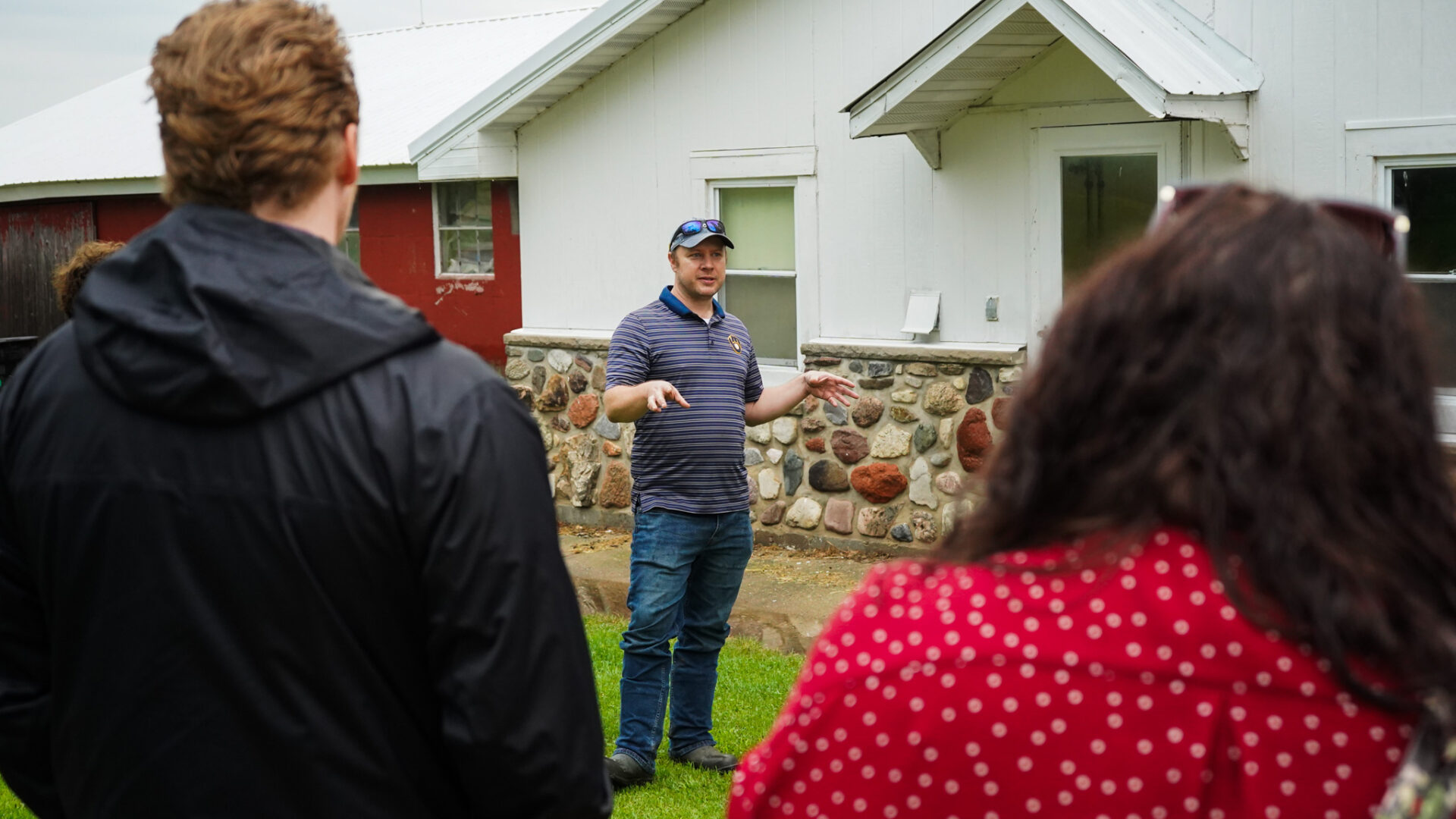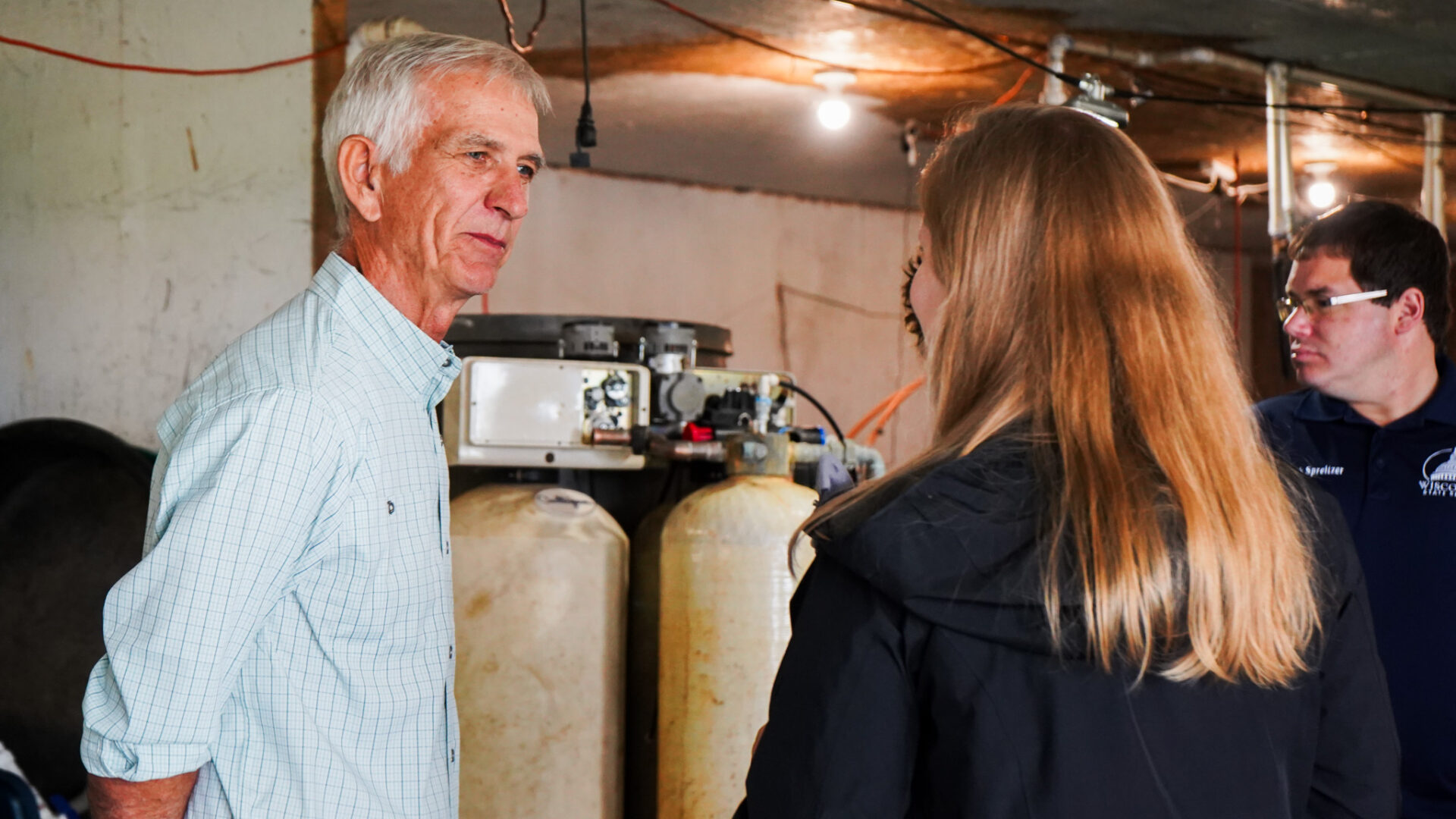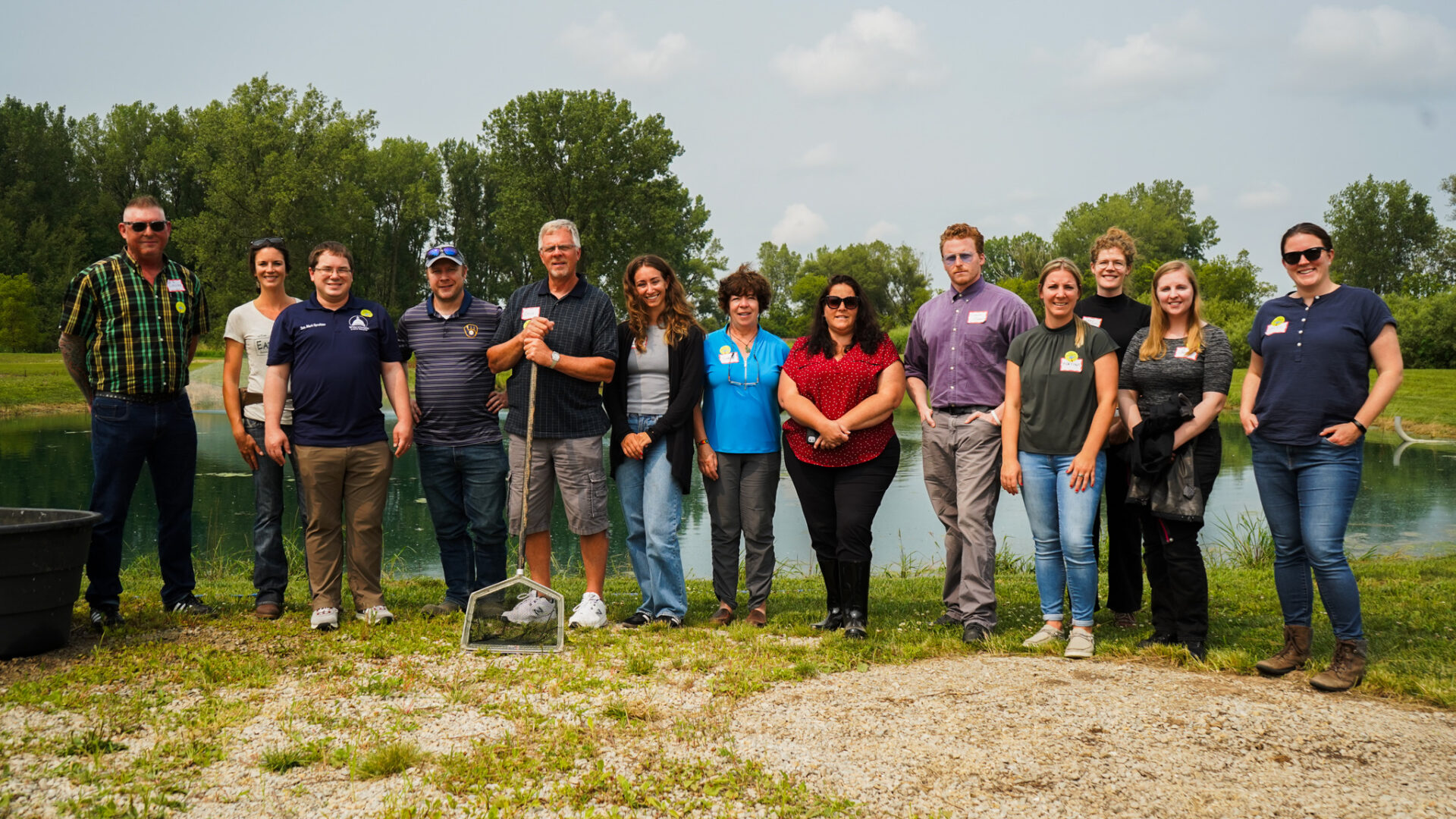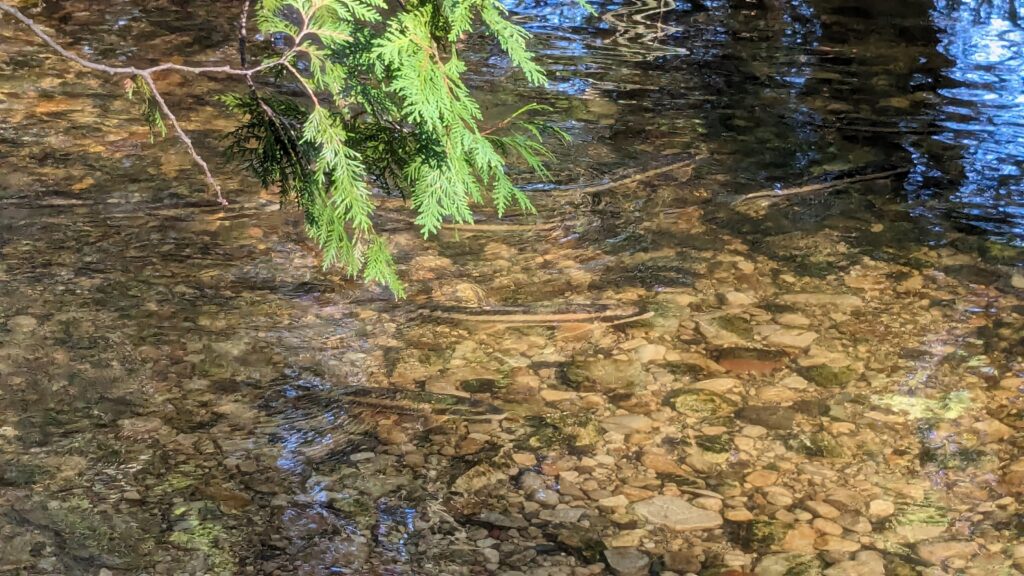A fish farm field trip for Wisconsin decision-makers highlights challenges and future of aquaculture

Peter Shep discusses fish farming in front of the milking parlor that houses his aquaculture operation. Photo: Wisconsin Sea Grant
When a small group of Wisconsin lawmakers and their staff peered into a milking parlor in Stoughton, Wisconsin, in late July, they learned that that not all dairy barns have cows. Some have fish.
The visit to Mulberry Aquaponics and Hatchery was the first stop on a tour of four fish farms in southern Wisconsin that also included Northey Farms in Deerfield, Rushing Waters Fisheries in Palmyra and Crystal Clear Fish Farm in Beaver Dam. Hosted by Wisconsin Sea Grant and industry partners, the tour brought together decision-makers to learn more about aquaculture and the challenges fish farmers face. State Senator Mark Spreitzer and staff from the offices of state Reps. Rozar, Moses and Shankland were all in attendance as were Lauren Kisley, the new veterinary program manager from the Wisconsin Department of Agriculture, Trade and Consumer Protection, and Ben Gollon, president of the Wisconsin Aquaculture Association and president/CEO at Gollon Brothers Wholesale Live Bait Inc.
Sharon Moen, Wisconsin Sea Grant food-fish outreach coordinator, organized the tour with fish farmers and funding from the National Sea Grant office.
“This tour was a direct response to a needs assessment Wisconsin Sea Grant conducted with fish farmers,” said Moen. “The farmers prioritized developing better lines of communication with decision-makers so we designed an opportunity where that could happen. We loaded fish farmers, decision-makers and Sea Grant facilitators aboard two minivans and drove 150 miles with stops at four fish farms and one Kwik Trip, having meaningful conversations along the way.”
Stop one: Growing perch in a barn
Inside the milking parlor at Mulberry Aquaponics and Hatchery, fish farmer Peter Shep explained how he raises yellow perch from egg to fingerling using a recirculating aquaculture system, which filters and recycles up to 90% of the water. This specialized equipment can be costly, but Shep used inexpensive materials like stock tanks, PVC pipes and solar-powered pumps to craft an affordable but effective system.

Shep dips a net into one of the tanks where he raises yellow perch. Photo: Wisconsin Sea Grant
His graduate education helped. Shep started the business after graduating from the University of Wisconsin-Milwaukee School of Freshwater Sciences, where he worked with Professor Dong-Fang Deng, who specializes in yellow perch production.
Raising fish in a gleaming, high-tech university lab, however, is not the same as raising fish in a renovated dairy barn. Despite using similar methods, Shep’s tanks produced fewer yellow perch per gallon than those at the university. The difference underlined the need for more research to be done on actual fish farms, where conditions are different than those in the lab. Wanting to solve some of the research-to-application challenges, he is returning to school in fall to pursue a doctorate degree in the Deng lab.
Shep also cited the technical challenges of raising perch, which are prone to dying within the first 30 days. In addition to being “finnicky,” perch are learning to eat and don’t always direct their hunger at the right thing. “They love to eat each other,” he said, showing photographic evidence to a rapt tour group.
If the perch survive, fingerlings are sold to “grow-out” farms that raise fish to the desired size for stocking in lakes or ponds. And demand is high. One buyer was interested in purchasing up to 250,000 fingerlings, which is more than double Mulberry Aquaponics’ goal for 2024.
Stop two: Where experience and innovation meet

Dave Northey discusses trying out recirculating aquaculture with the tour group. Photo: Wisconsin Sea Grant
The next stop was Northey Farms in Deerfield, where owner Dave Northey has raised yellow perch for nearly 30 years. Walking into an outbuilding, the tour group peeked into tanks that looked a lot like Shep’s.
Northey used to rear 300,000 to 900,000 fish exclusively in outdoor ponds, but several bad years and a serendipitous meeting with Shep encouraged him to try a recirculating aquaculture system. Compared to the pond system, Northey said RAS uses less water and offers the opportunity for multiple crops per year.
While production hasn’t bounced back to previous levels, Northey continues to work with Shep and Doug Sackett of Crystal Clear Fish Farm to optimize their systems and try new things. In this informal “co-op,” the trio share information as colleagues rather than competitors.
Stop three: Raising rainbow trout for the dinner plate

Peter Fritsch of Rushing Waters took the group on a tour of the outdoor ponds where he raises rainbow trout. Photo: Wisconsin Sea Grant
Heading east, the tour’s lunchtime stop was at the state’s largest commercial rainbow trout farm, Rushing Waters Fisheries in Palmyra. The 80-acre farm produces around 225,000 pounds of fish per year in outdoor ponds and features a seafood processing facility that makes fish products sold on-site and in stores. Fish are raised from egg to harvest right on the farm.
Owner Peter Fritsch explained that the ponds where he raises rainbow trout are spring-fed and hover around 50 degrees year-round. The consistently cold temperature is what makes trout farming possible, as trout need cold water to survive.
Being spring-fed, the waters were also clear and the fish easy to spot — not just for humans, but also birds. Fritsch said great blue herons and eagles like the easy pickings of ponds filled with fish and often hang around the farm. In the past, he used netting to deter predators and now uses laser technology to scare birds away.
Over a lunch of salmon burgers (a product processed and sold by Rushing Waters), Fritsch discussed further challenges fish farmers face, such as securing permits and the differences between federal and state regulations of fish farms. Another one is the high cost of starting and sustaining a farm.
“How do you make a little money in aquaculture? Start with a lot,” joked Fritsch. He encouraged the decision-makers to think about ways they can support fish farmers and those new to the industry.
Stop four: Making fish big

Doug Sackett of Crystal Clear Farms (right) nets yellow perch for a photo op with Sen. Spreitzer. Photo: Wisconsin Sea Grant
With fish on the mind and in the belly, the tour headed toward the fourth and final stop with Doug Sackett, owner of Crystal Clear Fish Farm in Beaver Dam.
Sackett runs a “grow-out” farm, where — like the name suggests — he grows out fingerling yellow perch in eight outdoor ponds to be stocked in lakes across the state. He purchases his fingerlings from both Shep and Northey and is part of their informal co-op.
Sackett’s goal is to keep the fish healthy and make them big, usually between 5 and 7 inches. He feeds fish twice a day, propelling pellets into the pond with a leaf blower, and works to maintain the appropriate temperature and dissolved oxygen levels. In fall, once the fish are big enough, he uses seine nets to corral and remove them from the ponds. The fish are then transported via truck to lakes and ponds. Most of Sackett’s clients are lake associations looking to boost numbers of yellow perch in their lake.
Sen. Spreitzer posed with one of Sackett’s perch but wasn’t spared the splash as the fish flopped back to the water.
Back on the bus, the wheels continue to turn on the future of Wisconsin aquaculture
As tour attendees boarded the vans to return to Madison, Sackett chatted with Ben Gollon, president of the Wisconsin Aquaculture Association, and Wisconsin Sea Grant aquaculture outreach specialist, Emma Hauser, about strategies for increasing oxygen in the ponds while keeping them cool during the hot summer months. The discussion was yet another example of how this excursion brought farmers, researchers and extension folks together in sharing knowledge and making connections.
The tour also invited lawmakers and legislative staff into the aquaculture conversation, many of whom asked questions of fish farmers on the car rides between stops. One asked whether fish, like other crops, could be insured; another asked about how to start an aquaponics system, which uses nutrients from fish waste to grow greens, at home. Others wanted to know more about how regulation works within the industry.
Knowledge sharing, however, wasn’t a one-way street: Fish farmers also had a chance to ask questions of decision-makers. They asked how and when to best connect with and educate lawmakers about the industry and discussed how bills become laws. Some were curious about what it was like to manage a campaign or run for office.
After the tour, Gollon asked, “This was such a great tour and discussion. Let’s do it again. Where are we going to go next?”
Moen said she was pleased by the depth of the questions and conversations during the tour and pointed toward more opportunities for connecting in the future. She said, “I think we can call this a resounding success as the fish farmers are talking about ‘next time’ and the legislative participants suggested that Wisconsin Sea Grant and fish farmers cooperate to hold a briefing at the state capitol. And — spoiler alert — we recently received word that our proposal to organize this type of opportunity in 2025 received funding.”
This project was made possible by a grant from the National Sea Grant Office (NOAA-OAR-SG-2023-2007550) to the Ohio (lead), Wisconsin and Minnesota Sea Grant programs.

Fish farmers, decision-makers and Sea Grant staff pose for a photo in front of Crystal Clear Fish Farm’s yellow perch ponds. Photo: Wisconsin Sea Grant
The post A fish farm field trip for Wisconsin decision-makers highlights challenges and future of aquaculture first appeared on Wisconsin Sea Grant.
News Releases | Wisconsin Sea Grant
News Releases | Wisconsin Sea Grant
https://www.seagrant.wisc.edu/news/a-fish-farm-field-trip-for-wisconsin-decision-makers-highlights-challenges-and-future-of-aquaculture/


